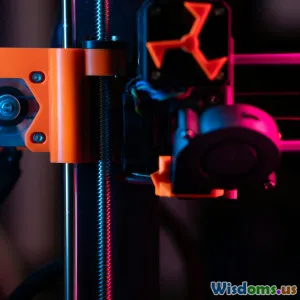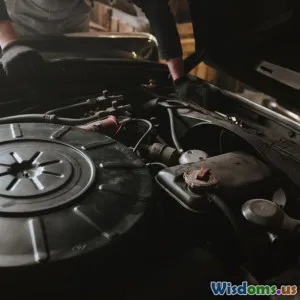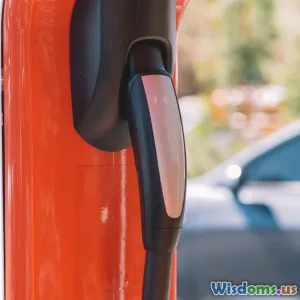
Can 3D Printing Revolutionize Auto Parts Replacement
9 min read Discover how 3D printing is transforming auto parts replacement with faster, cost-effective, and customized solutions. (0 Reviews)
Can 3D Printing Revolutionize Auto Parts Replacement?
The automotive industry is no stranger to innovation, from electric drivetrains to autonomous vehicles. Yet, one transformative technology quietly gaining traction in the background is 3D printing—also known as additive manufacturing. Could this pioneering method disrupt how we replace critical auto parts and maintain vehicles?
Introduction
Imagine needing a rare replacement part for your car’s aging engine — but the manufacturer ceased production years ago. Traditionally, owners face high costs, long wait times for restocking, or resort to second-hand parts with uncertain quality. However, 3D printing offers a radical alternative: the ability to produce parts on demand, locally, and tailored precisely to specifications. This capability could save hundreds of dollars, dramatically speed repairs, and reduce waste in the automotive aftermarket.
Empowered by advances in materials science, rapid prototyping, and digital design, 3D printing stands on the verge of revolutionizing how we maintain and extend the life of vehicles. Let’s delve deeper into the multifaceted impact of this technology.
How 3D Printing Works in Auto Parts Production
In traditional manufacturing, parts are made by machining pieces from metal blocks, molding plastic, or casting. This offers high volumes but lacks agility and demands costly tooling.
Contrastingly, 3D printing builds parts layer by layer from digital models using materials such as polymers, metals, or composites. This additive process enables:
- On-demand manufacturing: Parts can be produced immediately without batch production.
- Complex geometries: Intricate designs unachievable by conventional methods.
- Customization: Components tailored for specific vehicles or performance needs.
Automotive 3D printing involves multiple technologies like Fused Deposition Modeling (FDM) for plastics, Selective Laser Sintering (SLS), and Direct Metal Laser Sintering (DMLS) for metal parts. Each method suits different applications depending on part function and strength requirements.
Advantages of 3D Printing in Auto Parts Replacement
1. Speed and Availability
A major bottleneck in vehicle repairs is waiting weeks for parts to arrive from remote warehouses. 3D printing slashes this time dramatically by enabling shops or dealerships to print parts onsite. A study by Wohlers Associates reports that rapid prototyping reduces lead times by up to 70%, facilitating quicker repairs and less downtime.
For rare or obsolete parts, digital files can be stored indefinitely. When replacement is needed, the part can be fabricated immediately without new tooling.
2. Cost Efficiency
Although 3D-printed parts sometimes carry a premium in material costs, companies avoid large inventory expenses, storage fees, and lengthy logistics chains. For example, BMW has integrated 3D printing in its service; they reported reducing supply chain costs by up to 5% while increasing flexibility.
Additionally, repair shops can print customized jigs, fixtures, or even partial parts, lowering the cost of labor and complex repairs.
3. Sustainability
3D printing is inherently less wasteful since it only uses material where needed, contrasting the “subtractive” processes like milling that often discard large amounts of metal or plastic. This efficiency reduces environmental impact.
Furthermore, producing parts locally reduces carbon footprints associated with international shipping and packaging.
4. Customization and Innovation
3D printing empowers automotive engineers and mechanics to design parts optimized for performance or fit. Aftermarket performance parts—like lightweight engine brackets or aerodynamically enhanced spoilers—can be built rapidly.
In motorsports, teams use 3D printing to validate new part designs within hours, accelerating innovation cycles.
Real-World Applications and Examples
Ford’s Additive Manufacturing Initiatives
Ford Motor Company has embraced 3D printing extensively. Their Dearborn plant uses over 450 3D printers for prototyping and manufacturing parts. They’ve developed complex components like lightweight intake manifolds and structural brackets which reduce vehicle weight and improve fuel efficiency.
GE and Safran’s Advanced Jet Engine Parts
While aerospace goes beyond automotive, GE Aviation’s production of 3D-printed fuel nozzles for jet engines showcases the technology’s reliability under extreme conditions. This sets a precedent for producing durable, high-stress automotive parts like turbocharger components.
Classic Car Restoration
Owners of vintage or discontinued models increasingly rely on 3D printing. Instead of forging expensive new molds, specialists scan existing parts and produce exact duplicates, maintaining authenticity at lower costs.
Challenges Holding Back Widespread Adoption
Despite its promise, 3D printing in auto parts replacement faces several hurdles:
- Material limitations: Not all parts can yet match the strength, heat tolerance, or wear resistance of forged or cast metals.
- Regulatory standards: Safety-critical parts must comply with rigorous certifications, which can be complex with novel manufacturing methods.
- Digital data security: There are concerns over intellectual property rights and unauthorized file sharing.
- Cost for large scale: Though ideal for small or intricate parts, 3D printing large components at mass scale can still be cost-prohibitive.
What's Next? The Future of 3D Printing in Automotive Maintenance
Looking ahead, ongoing innovations are addressing these challenges. New composites and metal alloys specifically developed for additive manufacturing are improving part durability. Organizations like ASTM International are working toward standardized testing and certification protocols.
Integration of AI-driven design tools can further optimize parts for additive processes, maximizing performance and minimizing waste.
Moreover, as 5G and IoT expand, smart factories and repair hubs could share digital part blueprints instantly worldwide, enabling decentralized production networks.
Conclusion
3D printing holds tremendous potential to revolutionize auto parts replacement by making repairs faster, more cost-effective, and customized than ever before. While still facing material and regulatory roadblocks, real-world projects from automotive giants and startups alike prove the technology’s viability.
As 3D printing materials and processes mature, expect a future where vehicle downtime shrinks, classic cars receive authentic parts at a fraction of the cost, and sustainable manufacturing reduces automotive emissions. The question is not if 3D printing will revolutionize auto parts replacement—but rather when—and who will lead the charge.
Call to Action: Car owners and mechanics should stay informed on 3D printing advancements and consider partnerships with tech providers to leverage this disruptive innovation. Auto industry stakeholders must invest in R&D to scale additive manufacturing safely, sustainably, and at competitive prices, ensuring vehicles on the road are easy to maintain and evolve with times.
References
- Wohlers Report 2023: Additive Manufacturing Trends
- BMW Group Annual Report 2022
- Ford Motor Company Innovation Highlights
- GE Aviation 3D Printed Jet Engine Nozzle Case Study
Rate the Post
User Reviews
Popular Posts





















